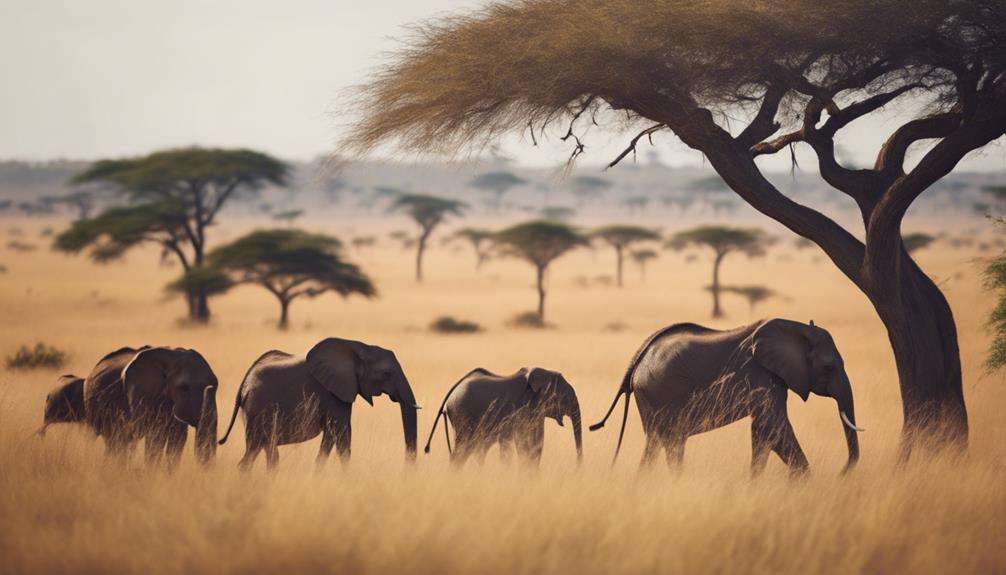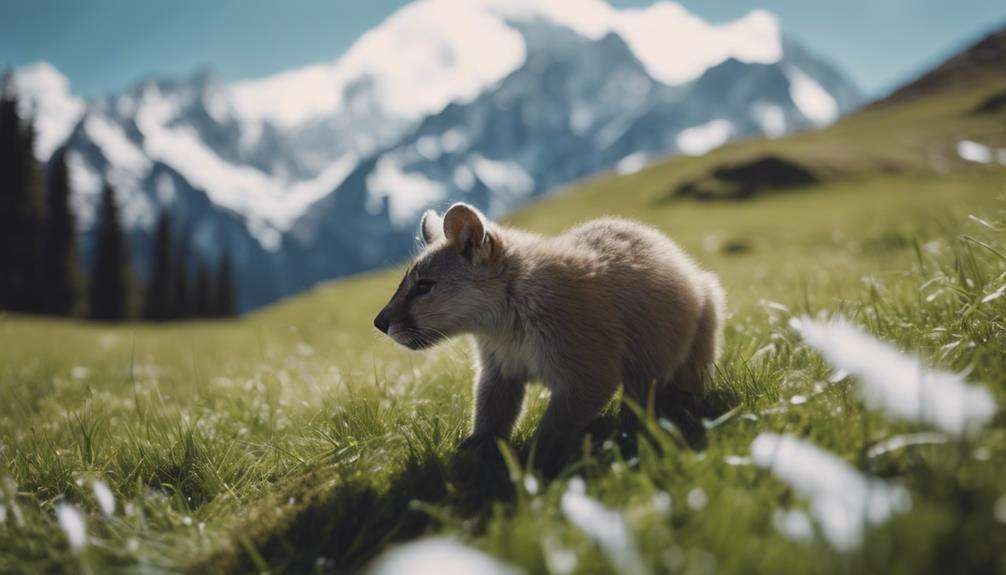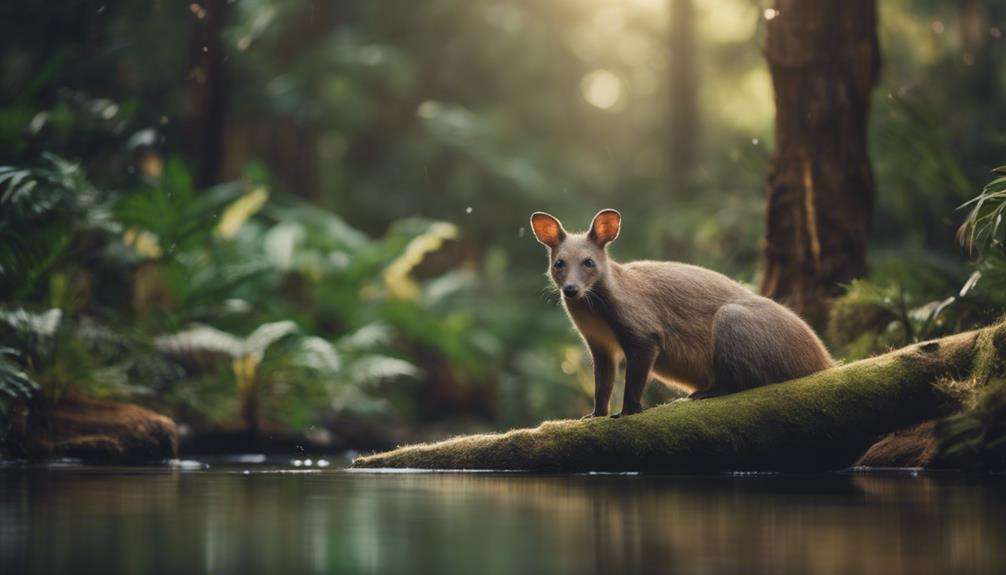Imagine exotic mammals as pieces of a complex puzzle, intricately designed to fit into their unique natural habitats. But where exactly do these fascinating creatures belong in the vast tapestry of ecosystems?
Unravel the mystery of exotic mammals' natural habitats and discover the surprising diversity of environments they call home. Explore the lush depths of tropical rainforests, the icy expanses of the Arctic tundra, the sweeping vistas of savannas, and more.
Their habitats offer valuable insights into the intricate balance between these animals and their surroundings, shedding light on the importance of preservation and conservation efforts.
Key Takeaways
- Exotic mammals thrive in diverse habitats like tropical rainforests, arctic tundra, savannas, and wetlands.
- Specialized adaptations enable exotic mammals to survive in extreme environments such as deserts and mountains.
- Coastal and marine environments provide unique habitats for exotic mammals like seals and otters.
- Canopy, understory, and open grassland habitats offer varied niches for exotic mammals to inhabit.
Tropical Rainforests
Tropical rainforests harbor a diverse array of exotic mammals, thriving in the lush, humid environment characterized by consistent temperatures and abundant food sources. These natural habitats provide a haven for various exotic mammals, including primates like monkeys and apes, as well as unique small mammals such as tree shrews and flying squirrels. The dense vegetation and canopy cover in tropical rainforests create a complex ecosystem where exotic mammals exhibit specialized behaviors and adaptations to navigate their surroundings effectively.
Conservation efforts play a vital role in preserving the natural habitats of these exotic mammals and maintaining the overall biodiversity of tropical rainforests. By protecting these ecosystems, conservationists aim to safeguard the diverse array of species that call these rainforests home. Understanding the specialized behaviors of exotic mammals in their natural habitat is crucial for developing effective conservation strategies that ensure the long-term survival of these fascinating creatures. Through concerted conservation efforts, we can help secure the future of exotic mammals in tropical rainforests.
Arctic Tundra
Located in the Earth's northernmost regions, the Arctic tundra is a cold and treeless biome characterized by long, harsh winters and short, cool summers. This extreme cold environment is home to native mammals such as polar bears, Arctic foxes, musk oxen, and caribou. These animals have evolved specialized adaptations to survive in the challenging conditions of the tundra. Thick fur coats provide insulation, while specialized fat reserves serve as an energy source during food scarcity. Behavioral adaptations, like hibernation or migration, help these mammals endure the harsh climate and limited vegetation of the Arctic tundra.
The fragile ecosystem of the Arctic tundra supports a diverse range of wildlife, making conservation efforts essential to protect these unique habitats. Climate change and human activities pose significant threats to the delicate balance of this environment, emphasizing the importance of wildlife conservation initiatives in preserving the Arctic tundra and its native mammal species.
Savannas and Grasslands

In savannas and grasslands, exotic mammals such as zebras, giraffes, and elephants thrive in vast open spaces with scattered trees and shrubs, benefiting from ample grazing opportunities. These natural habitats provide a suitable environment for herbivorous mammals to forage on the diverse vegetation present. The biodiversity in savannas and grasslands supports a complex ecosystem where exotic mammals play crucial roles in maintaining the balance. These mammals have adapted to the seasonal changes in rainfall, temperature, and food availability, showcasing their resilience in dynamic environments.
Predators like lions, cheetahs, and hyenas also find a home in these habitats, preying on the herbivorous mammals and contributing to the intricate food web of the savannas and grasslands. The coexistence of these exotic mammals and predators highlights the interconnectedness of species within these ecosystems.
Deserts and Arid Regions
Exotic mammals inhabiting deserts and arid regions demonstrate remarkable adaptations to endure extreme temperatures and scarcity of water resources. Species such as the Fennec fox and camels have evolved specialized adaptations to thrive in these harsh environments. Deserts are characterized by sparse vegetation, sand dunes, and rocky terrain, providing shelter for these animals. Mammals in arid regions have developed unique mechanisms to conserve water, such as efficient water retention and nocturnal behavior to avoid the scorching sun.
The natural habitat of exotic animals in deserts showcases their ability to withstand challenging conditions through desert adaptations. These include heat tolerance, water conservation strategies, and behavioral modifications that allow them to survive in arid regions. The specialized adaptations of these mammals highlight their remarkable capacity to thrive in environments where resources are limited and temperatures are extreme. By evolving to fit the demands of desert ecosystems, exotic mammals have carved out a niche in these arid regions, showcasing the resilience and ingenuity of nature.
Mountains and Alpine Zones

In mountainous habitats, exotic mammals have evolved to thrive in extreme conditions, such as low oxygen levels and harsh climates. Alpine zones offer a unique environment that challenges these mammals to develop specialized adaptations for survival.
Species like snow leopards and mountain goats demonstrate remarkable abilities to navigate rugged terrains and harsh weather in high-altitude regions.
High-Altitude Mammal Habitats
Amidst the rugged terrain and harsh weather conditions of mountain ranges and alpine zones, high-altitude mammal habitats showcase remarkable adaptations to extreme environments.
- Mammals in high-altitude habitats face challenges like low oxygen levels and extreme cold, pushing them to develop unique survival strategies.
- Species such as the snow leopard, mountain goat, and Himalayan tahr have evolved to thrive in these demanding environments.
- The steep cliffs, rocky outcrops, and sparse vegetation in these habitats provide a diverse range of obstacles for mammals to overcome.
- High-altitude mammal habitats are vital for maintaining biodiversity and ecological balance in mountain ecosystems, highlighting the significance of these specialized environments.
Adaptations to Mountain Life
Adaptations to mountain life in high-altitude mammal habitats showcase remarkable strategies developed by species to thrive in extreme environments. Exotic mammals in these habitats have evolved thick fur coats that provide insulation against cold temperatures, essential for survival in the harsh mountain climate.
Additionally, many of these mammals possess large, strong claws that aid in climbing steep terrain and navigating rocky landscapes with ease. To adapt to the challenges of high altitudes, these mammals have developed efficient oxygen utilization in their bloodstream, ensuring their survival in oxygen-deficient environments.
Furthermore, specialized diets play a crucial role in sustaining their energy needs in such challenging habitats. Some exotic mammals, like mountain goats, have evolved specialized hooves that provide exceptional traction on rocky surfaces, enabling them to move confidently in mountainous terrains.
Wetlands and Swamps
Nestled within the intricate network of wetlands and swamps lie the natural habitats where exotic mammals like capybaras, otters, and tapirs flourish. These environments offer a unique blend of resources and conditions that cater to the specific needs of these fascinating creatures.
- The wetlands and swamps provide a diverse range of water sources, from slow-moving rivers to shallow ponds, ensuring exotic mammals have access to hydration and opportunities for aquatic foraging.
- Lush vegetation in these habitats supports a variety of plant species, which in turn attract a myriad of prey animals for exotic mammals to hunt.
- Exotic mammals in wetlands and swamps often possess specialized adaptations for swimming, such as webbed feet and streamlined bodies, enabling them to navigate through water with ease.
- The high biodiversity present in wetlands and swamps creates a rich ecosystem where exotic mammals can coexist with numerous other species, fostering interconnected relationships vital for the survival of these animals.
Coastal and Marine Environments

Within coastal and marine environments, exotic mammals such as seals, sea lions, and otters thrive due to their adept adaptations to the challenges and opportunities presented by these ecosystems. Coastal areas, including beaches, mangrove forests, and rocky shores, provide diverse habitats for these mammals.
Marine environments offer additional opportunities for species like seals to thrive in the water. Coastal habitats grant exotic mammals access to both land and water, facilitating activities such as foraging and breeding. The rich biodiversity of the ocean supports these mammals by offering a variety of food sources and shelter.
Exotic mammals in coastal regions have evolved specialized traits to navigate the unique demands of these ecosystems, ensuring their survival. By taking advantage of the resources available in coastal and marine environments, these mammals have carved out ecological niches that allow them to flourish in these dynamic and challenging habitats.
Frequently Asked Questions
Why Do Exotic Animals Belong in Their Natural Habitat?
Exotic animals belong in their natural habitat for their well-being. It ensures their physical health, mental stability, and behavioral balance. Conservation efforts focus on wildlife rehabilitation, biodiversity preservation, and maintaining ecological balance. Human intervention is crucial for animal welfare and natural instincts.
Where Are Exotic Animals Kept?
You keep exotic animals in environments that mimic their natural habitats. Wildlife sanctuaries, zoos, and private collections provide appropriate settings to cater to their needs. Habitat replication is crucial for their well-being, ensuring temperature, humidity, vegetation, and space are considered.
What Do Exotic Animals Need to Survive?
To survive, exotic mammals need adequate food sources, shelter requirements, social interactions, environmental adaptations, and awareness of predation risks in their natural habitats. These elements are crucial for their well-being and long-term survival.
Where Are the Most Exotic Animals?
Explore diverse ecosystems worldwide where exotic mammals thrive, from wildlife sanctuaries to rainforest canopies, savannah grasslands, Arctic tundras, and desert oases. Witness the wonders of nature in their natural habitats.
Conclusion
Have you ever considered the diverse natural habitats of exotic mammals?
From the lush tropical rainforests to the harsh Arctic tundra, these animals have evolved to thrive in a variety of environments.
Understanding and replicating these habitats in captivity is crucial for the well-being of exotic mammals.
By providing the right conditions and enrichment, we can ensure that these fascinating creatures continue to flourish and thrive in our care.






